Dogs truly earn their title as “man’s best friend,” especially when they come in the form of big, fluffy bundles of joy. These giant teddy bears are the ultimate cuddle buddies—massive, soft, and full of heart. Whether they’re sprawling out in the backyard or curling up beside you on the couch, their gentle nature and cloud-like fur make them impossible to resist.
Dreaming of a fluffy giant? From their affectionate puppy eyes to their laid-back personalities, these big dogs are more than just show-stoppers—they’re loving companions who thrive on snuggles and loyalty. Perfect for homes with space to roam, many of these breeds are surprisingly calm indoors, needing just a daily dose of exercise to stay happy and healthy.
But heads up: owning a fluffy giant means accepting the inevitable fur tumbleweed drifting through your home—shedding is a full-time job for these majestic coats. Still, the soft, plush fur and the warmth they bring make every hair worth it.
If you want a dog that’s as big on love as they are on size, these gentle giants are waiting to become your next best friend. Ready to meet your new walking comforter? Because when it comes to big, fluffy dogs, bigger truly is better.
Top 22 Big Fluffy Dog Breeds You’ll Love
1. Old English Sheepdog
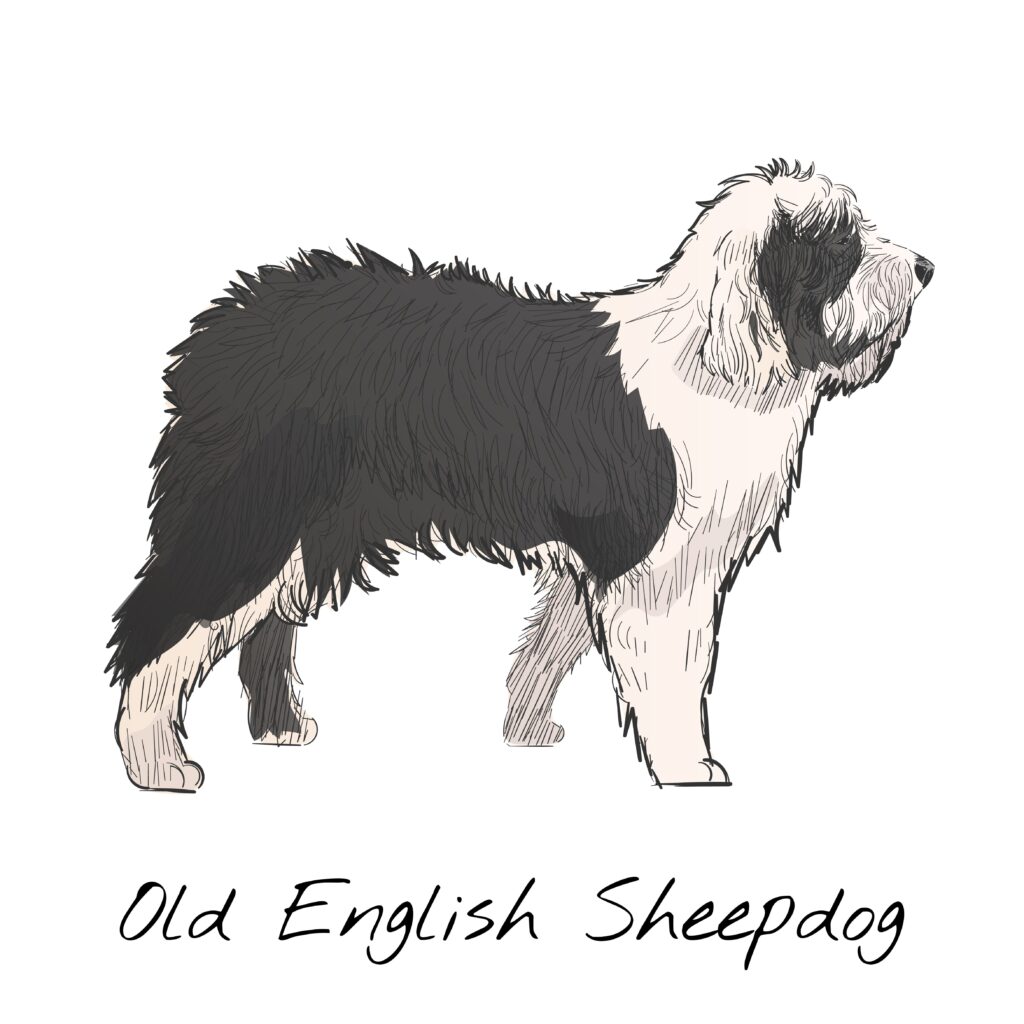
The Old English Sheepdog is a big, shaggy, lovable dog that looks just like a walking cloud or a real-life teddy bear! Known for its long, wooly coat and bouncy personality, this breed is full of charm and cuddles. Even though they’re called “Old English,” they aren’t that old (only around since the 1700s), and their roots may include European and Russian bloodlines too.
Temperament
These dogs are gentle, playful, and smart. Originally bred to herd cattle and pull carts, the Old English Sheepdog is now more likely to be your snuggle buddy at home. They love being around people and do especially well with families and children. You might recognize the breed from Disney’s The Little Mermaid—Prince Eric’s dog Max was a fluffy Old English Sheepdog!
Although they’re large (weighing between 50–100 pounds), they are calm indoors and can even adapt to apartment life, as long as they get enough exercise. They’re also known for their clown-like sense of humor and bark only when needed.
Grooming Needs
Their fluffy double coat (with a soft undercoat and textured topcoat) is beautiful but high-maintenance. These dogs don’t shed seasonally, but that doesn’t mean you’re off the hook! You’ll need to brush them at least 3–4 hours per week, or even daily, to keep their coat tangle-free and clean. If mats form, shaving may be necessary. A trip to a professional groomer every 6–8 weeks can help manage their long hair and keep them looking their best.
The Old English Sheepdog is a loving, loyal, and goofy companion who brings joy to any home. If you’re ready for the grooming commitment and lots of fluffy hugs, this “shag carpet with legs” might just be the perfect dog for you!
2. Newfoundland
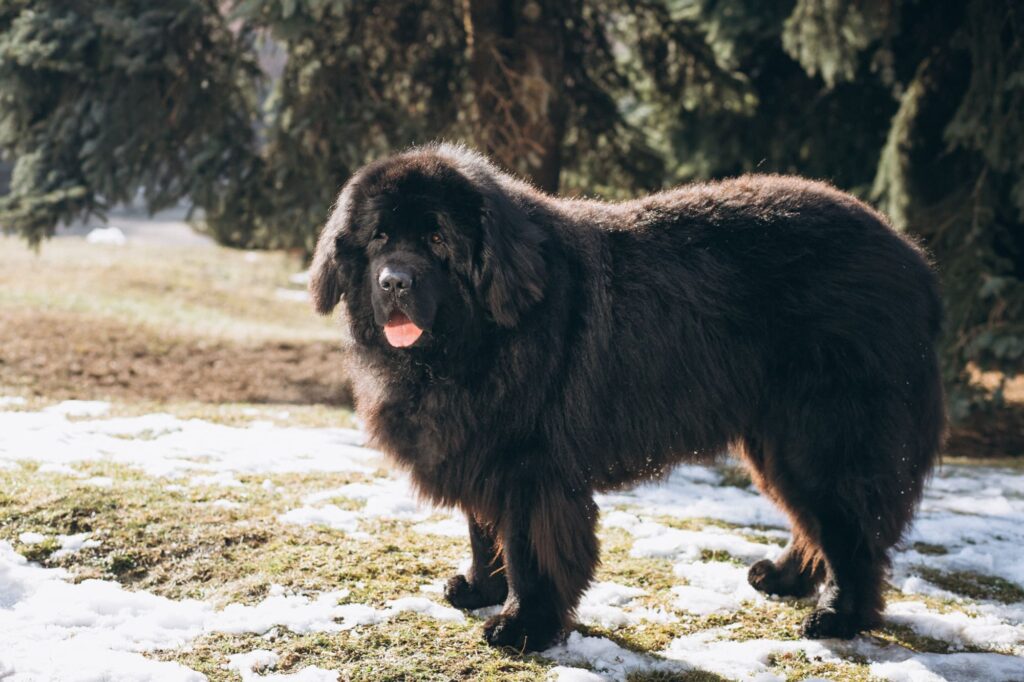
The Newfoundland, or “Newfie” as many lovingly call it, is the perfect example of a gentle giant. These big, fluffy dogs can weigh up to 150 pounds, but they have hearts just as large. Famous for their sweet, calm, and caring personality, Newfoundlands are wonderful with kids and often act like gentle nanny dogs. You might even remember Nana, the lovable dog from Peter Pan—she was a Newfie too!
Originally from Newfoundland, Canada, this breed was developed by fishermen who needed strong, water-loving dogs to rescue people, haul fishing nets, and pull boats. Their thick, water-resistant coat, webbed feet, and huge lung capacity made them excellent swimmers—some even call them the lifeguards of the dog world!
Temperament
Newfoundlands are known for their intelligence, empathy, and patience. They form deep bonds with their families and are especially gentle around children. These dogs naturally want to help and are quick to respond when someone’s in need—making them not just lovable pets, but also reliable companions.
Grooming Needs
That fluffy, double-layered coat might make them look like giant teddy bears, but it also means lots of grooming. Newfies shed a lot, and if you skip brushing, their soft undercoat can get tangled and painful. To keep their coat healthy and mat-free, you’ll need to brush them at least three times a week, or once a week minimum, and visit a professional groomer every 6–8 weeks. Oh—and prepare for some drool, too!
The Newfoundland is a strong, soulful, and loyal dog that’s perfect for families who have room in their home—and their hearts—for a giant, water-loving cuddle buddy. Whether pulling ropes, swimming in cold waters, or snuggling on the couch, a Newfie is always happy when it’s helping its humans.
3. Samoyed
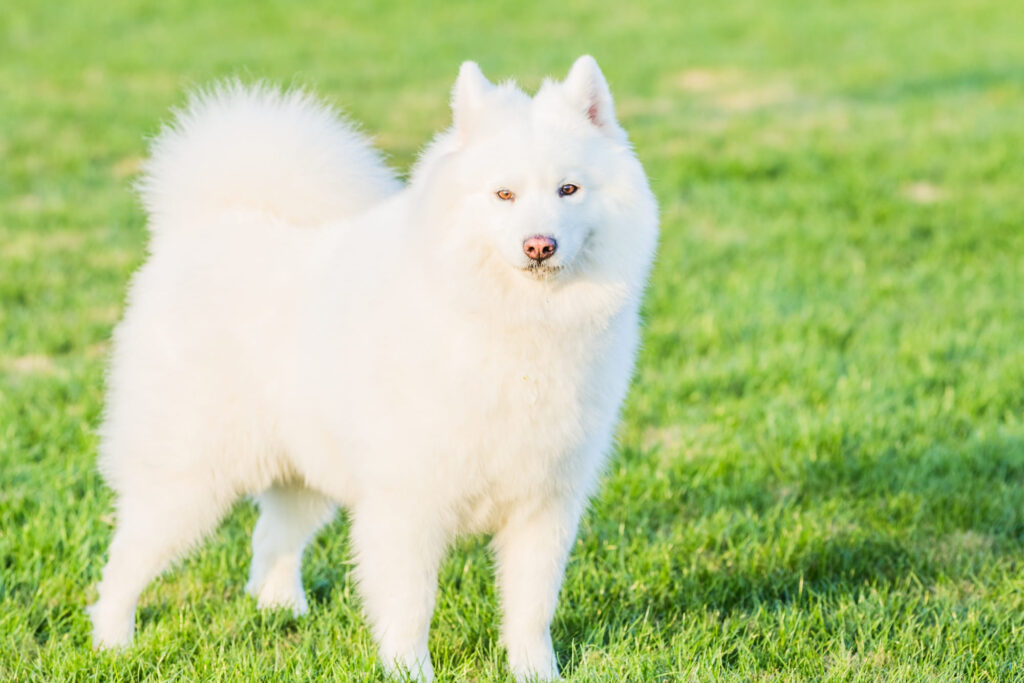
The Samoyed is a big, fluffy, white dog known for its signature “Sammy smile.” These cheerful pups come from the freezing lands of Siberia, where they were bred to herd reindeer, pull sleds, and even keep people warm on cold Arctic nights. That’s right—these dogs were literally made for snuggles!
Personality & Temperament
Samoyeds are friendly, gentle, and very social. They love being around people and are happiest when they’re included in everything the family does—whether it’s a walk, a game of fetch, or just lounging on the couch. Because they’re so pack-oriented, Samoyeds don’t like being left alone for too long.
They’re great with kids, love to play, and are very smart. However, they can be a little mischievous if they get bored, so make sure they get plenty of attention and exercise!
Grooming & Coat Care
That beautiful, snow-white coat isn’t just for looks—it’s a double coat that keeps the Samoyed warm in freezing temperatures. The topcoat is long and straight, and the undercoat is thick and soft. But all that fluff comes at a price…
- Samoyeds shed all year, and they shed a lot during shedding season (usually once or twice a year).
- Daily brushing is a must—especially during those heavy shed times—to prevent mats and tangles.
- Regular grooming keeps their coat healthy and helps reduce hair all over your house.
Best for Cold Climates
Because they come from Siberia, Samoyeds are built for cold weather. Their thick fur makes them uncomfortable in hot climates. If you live somewhere warm, you’ll need to keep them cool indoors and avoid long walks in the heat.
Fun Fact
Did you know that European explorers discovered the Samoyed in the 1800s and brought them on Arctic adventures? These dogs helped pull sleds, survive the cold, and even became companions to royalty when they arrived in England!
In Summary:
If you’re looking for a loyal, loving, and always-smiling companion that enjoys cuddles and playtime, the Samoyed might just be your perfect match—as long as you’re ready to handle the fluff!
4. Saint Bernard
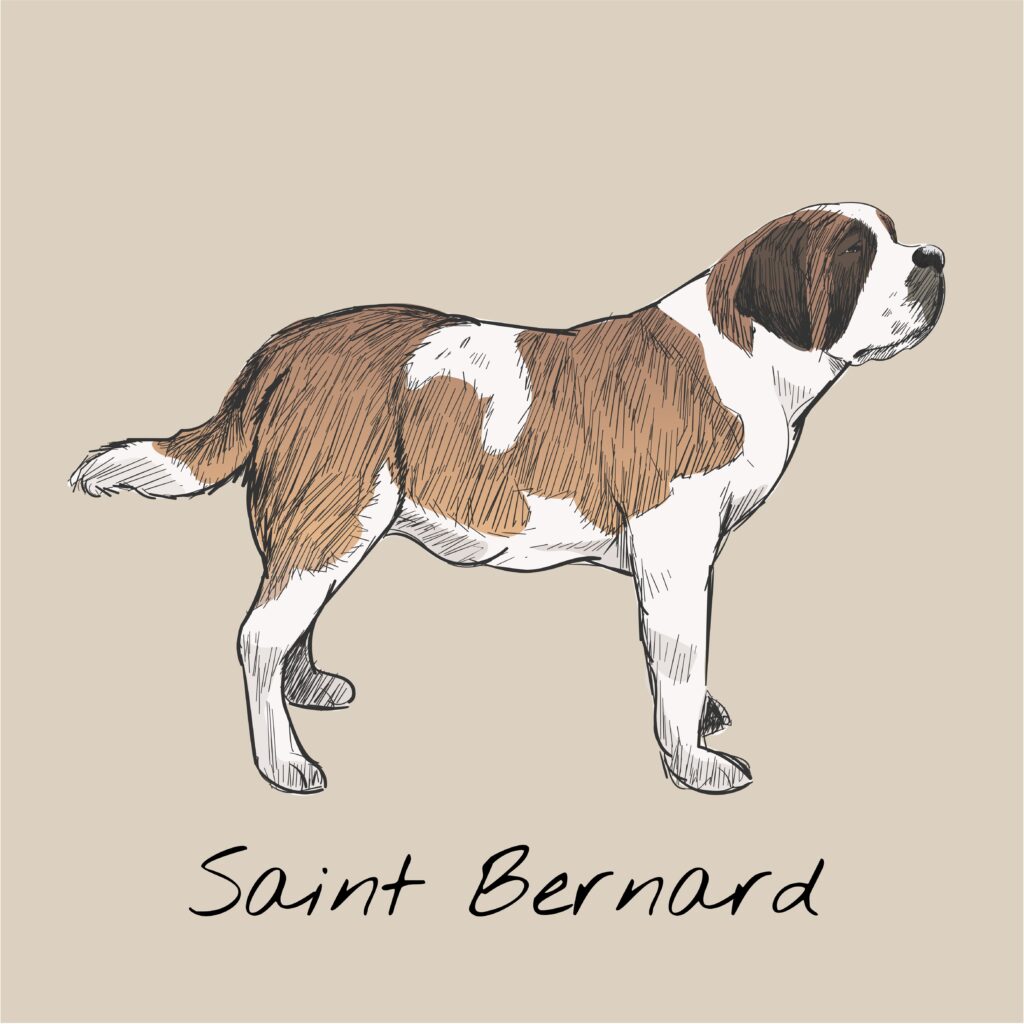
The Saint Bernard is a huge, fluffy dog famous for saving lost travelers in the snowy Swiss Alps. These dogs were once heroes in icy mountains, using their size and warmth to protect people from freezing temperatures. Today, they’re known as loving, loyal, and calm family dogs—the ultimate gentle giants.
Personality & Temperament
Don’t let their size scare you—Saint Bernards are sweet, patient, and super gentle. They’re great with kids and love to lounge around the house with their people. In fact, they’ll try to snuggle up on your couch—so be careful what habits you allow while they’re still puppies!
Saint Bernards:
- Are calm and easygoing
- Love to cuddle and be part of the family
- Are protective, but not aggressive
- Can be a little stubborn, so early training is a must
They’re not clumsy—they’re just big and slow-moving. But don’t be fooled—they can be surprisingly agile for their size.
Grooming & Coat Care
Saint Bernards come in two coat types: short and long. The long-haired version is the fluffy giant most people think of, usually red and white.
- These dogs shed a lot, especially during spring and fall.
- Brushing 2–3 times a week helps reduce shedding and keeps their coat tangle-free.
- Expect some drooling—okay, a lot of drooling—especially after eating or drinking.
- They’re also mud magnets, so plan to bathe them every 1–2 weeks if they love rolling around outside.
Space & Climate Needs
Saint Bernards are big dogs—some can weigh over 180 pounds and stand around 30 inches tall! They do best in homes with plenty of space and cooler climates. Their thick coat makes them great for cold weather, but they can overheat in hot places.
Natural Guardians
These dogs don’t need to bark much to protect your home. Just their size and deep “woof” are enough to scare off intruders. They’re not aggressive, but their presence is powerful.
Fun Fact
Remember the movie Beethoven? That lovable, slobbery dog was a Saint Bernard! But long before Hollywood, these dogs were already famous for their real-life hero work—saving lives in snowy mountain passes.
In Summary:
The Saint Bernard is a giant-sized cuddle buddy with a heart just as big. Loyal, loving, and protective, they’re perfect for families who have the space—and a mop—for all that fur and drool. If you’re looking for a dog who’s brave, sweet, and full of warmth (literally), this alpine hero might just be your next best friend.
5. Great Pyrenees
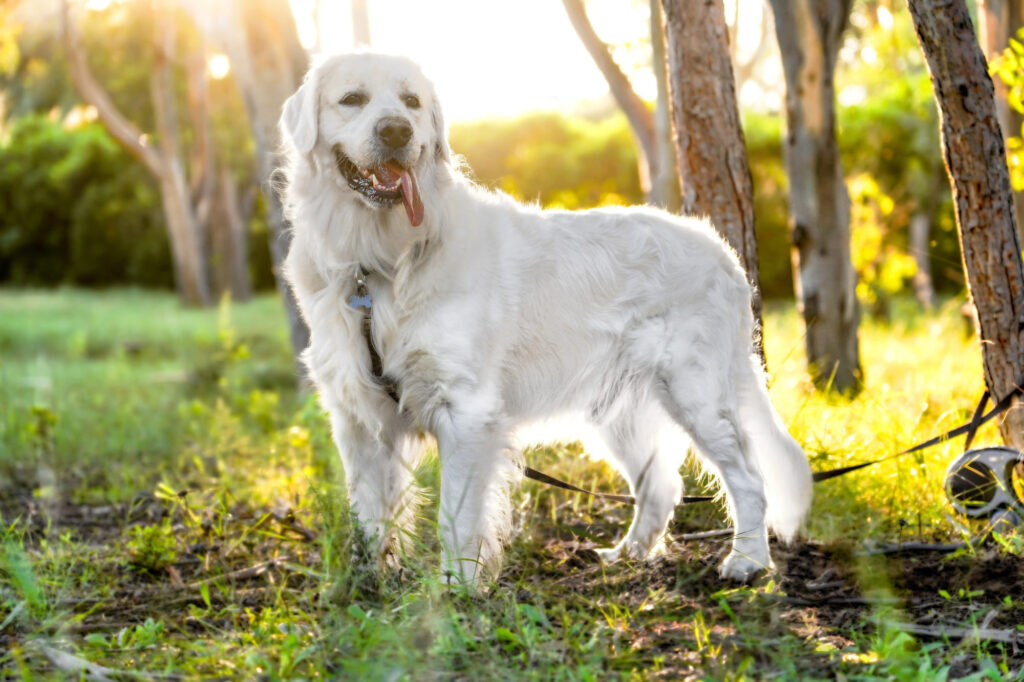
The Great Pyrenees is a big, white, fluffy dog that looks like it just walked out of a snow globe. But don’t be fooled by the soft appearance—this dog is a brave protector at heart.
Originally bred to guard sheep in the Pyrenees Mountains between France and Spain, these dogs were born to watch over flocks—even without humans around. That’s why they’re both independent and loyal—a unique combo that makes them amazing family pets.
Personality & Temperament
The Great Pyrenees is:
- Calm and gentle
- Very affectionate with their family
- Patient with children
- Protective without being aggressive
- Sometimes a little stubborn (they were bred to work alone!)
This means early training is important, especially since they’re smart but independent thinkers.
Grooming & Coat Care
That soft, fluffy white coat isn’t just for looks—it once protected these dogs in freezing mountain weather. But it does come with some grooming needs:
- Weekly brushing is a must to keep their coat healthy and clean.
- In spring, they shed a LOT to make room for a lighter summer coat—so get ready for a blizzard of fur!
- Bathe them when needed, but not too often—every few months is usually fine unless they get dirty.
Fun fact: Their thick double coat is weather-resistant and helps keep them cool in summer and warm in winter.
Size & Space Needs
The Great Pyrenees is huge—males can weigh up to 160 pounds and stand 32 inches tall! That means they need:
- Plenty of space to stretch out
- A home with a yard or access to outdoor time
- Regular exercise to stay healthy and happy
Natural Protector
These dogs were bred to guard flocks from wolves and bears, so they’re naturally alert and protective. While they’re not aggressive, they will bark to let you know something’s not right.
Their size alone is enough to scare off intruders—but their heart is what really stands out. They love their families deeply and want to keep everyone safe.
Fun Fact
The ancestors of the Great Pyrenees date back 10,000 years! That’s right—they’ve been guarding animals and homes since ancient times, making them one of the oldest dog breeds in the world.
In Summary:
The Great Pyrenees is a majestic and loving dog with a calm spirit and a giant heart. Their soft, snowy fur makes them the perfect cuddle buddy—but don’t forget, they’re also tough protectors who were born to watch over those they love. If you’ve got space, time for brushing, and a love for big, loyal dogs, the Great Pyrenees could be your perfect match.
6. Borzoi
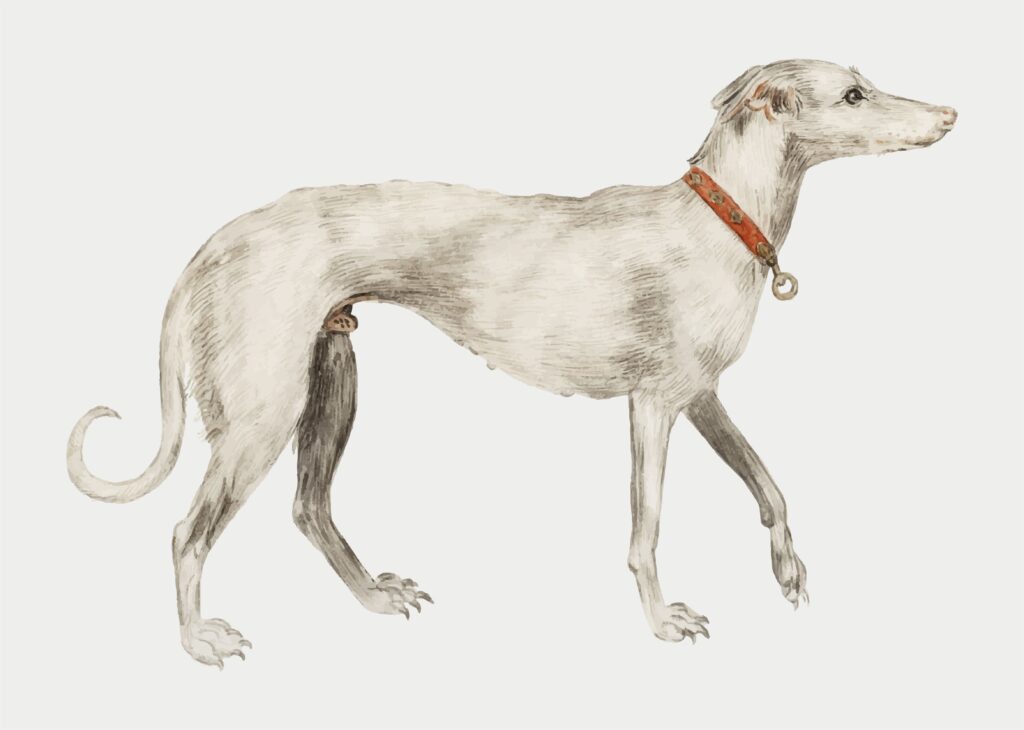
The Borzoi looks like it stepped out of a royal painting—tall, slim, and covered in long, silky fur. But don’t let that fancy look fool you—this dog is more than just a pretty face. Borzois are sweet, gentle, and love snuggling with their family.
Breed History & Speed
Once known as the Russian Wolfhound, the Borzoi was bred by royals in old Russia to chase wolves across snowy fields. These dogs are incredibly fast—they can run up to 40 miles per hour!
Today, they’re more likely to race around the backyard than chase wild animals. But they still need a good amount of daily exercise, especially in a fenced yard where they can stretch their legs safely.
Personality & Temperament
Borzois are:
- Gentle and quiet indoors
- Slightly shy or aloof with strangers
- Loving and cuddly with their people
- Calm and well-behaved around the house
They’re not big barkers, and they like their space, but once they bond with you, they’re loyal for life.
Coat & Grooming Needs
That long, flowing coat is one of the Borzoi’s most stunning features—but it takes some care:
- Brush gently once or twice a week to keep the coat smooth and tangle-free
- Daily brushing may be needed during shedding seasons or if mats form
- Bathing isn’t needed often, but a clean Borzoi always looks like royalty
Their fur can get knotty, especially behind the ears and legs, so regular grooming is key.
Size & Space
Borzois are tall and lean, often standing 26 to 32 inches high and weighing up to 100 pounds. Despite their size, they’re usually quiet and peaceful indoors. They make great apartment dogs—as long as they get their exercise outside.
Exercise & Play
While they love lounging, Borzois still have that sighthound instinct and need to run daily. A large fenced area or a secure dog park is ideal for these zoomies. Off-leash time should only happen in a safe, enclosed place, because their chase instinct is strong!
Fun Fact
The word “Borzoi” means “swift” in Russian—a perfect name for such a fast, graceful dog. In fact, they were once so prized that only Russian nobles were allowed to own them.
In Summary:
The Borzoi is a regal, gentle dog with a heart full of love and legs built for speed. If you want a graceful companion who’s quiet, cuddly, and looks like they belong in a castle—but runs like the wind—this silky speedster might just be your perfect match.
7. Bernese Mountain Dog
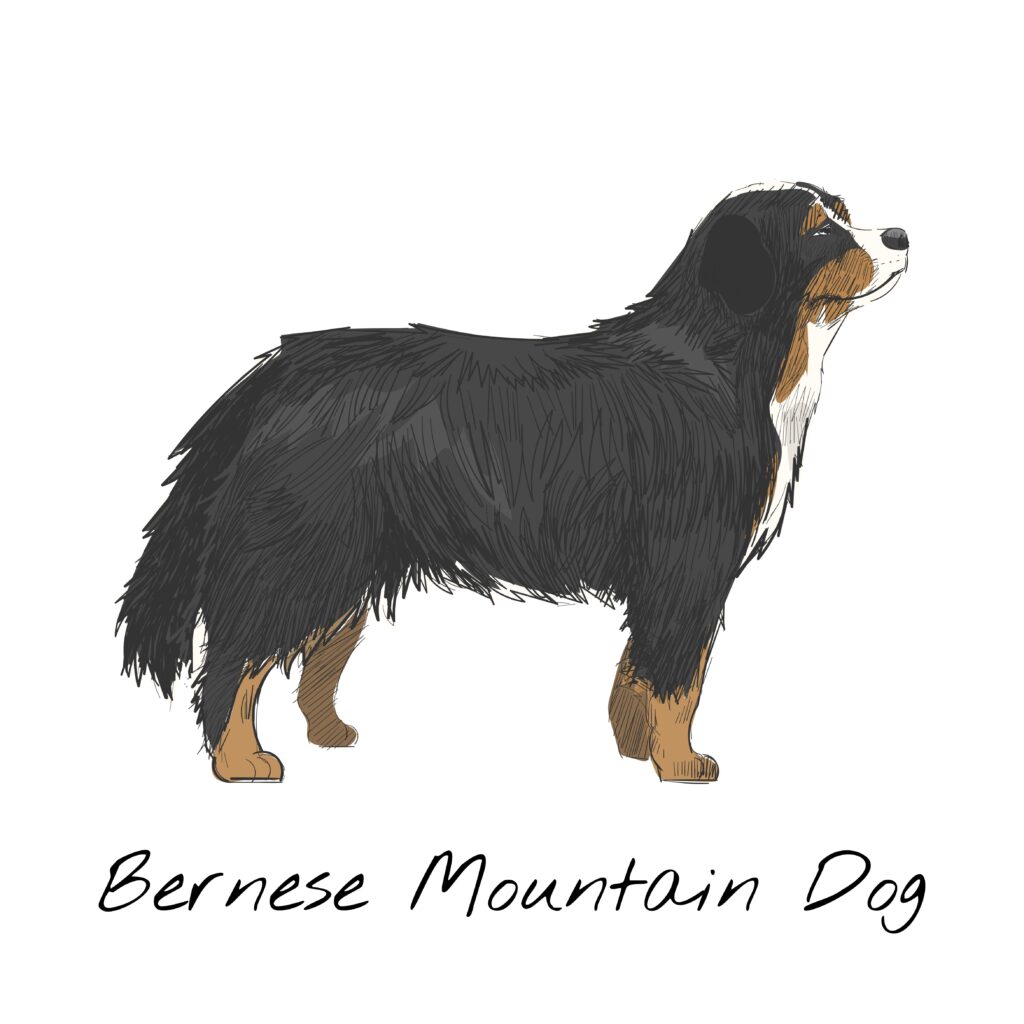
With its soft, tri-colored fur and sweet personality, the Bernese Mountain Dog is one of the most lovable breeds around. Big but gentle, this dog is a favorite for families—and it’s easy to see why.
Where They Come From
The Bernese Mountain Dog, or “Berner,” comes from the Swiss Alps. These dogs were once used to herd cattle, guard farms, and pull milk carts through the snowy mountains near the city of Bern. They’re strong, smart, and dependable, built for hard work in cold weather.
Temperament & Personality
Berners are known for being:
- Gentle and affectionate
- Loyal and loving
- Great with kids
- Calm, but still enjoy playtime and outdoor fun
They love being with their family and are known to follow their people from room to room. Berners are also used in therapy work and search and rescue because they’re so patient and friendly.
Trainable & Smart
These dogs are intelligent and like having a job to do—even if that’s just going on walks or helping carry a backpack. Because they’re so eager to please, they respond best to gentle, positive training. Shouting or harsh corrections won’t work as well.
Grooming That Gorgeous Coat
Bernese Mountain Dogs have a thick double coat made for mountain life. Here’s how to care for it:
- Brush 2–3 times a week, or daily during spring and fall (they shed more then)
- Bathe every 1–2 months or when dirty
- Watch for knots and tangles behind the ears and legs
They shed year-round, so regular brushing keeps fur off your furniture—and your clothes!
Size & Strength
These dogs are big! Most Berners weigh between 70 to 115 pounds and can stand up to 28 inches tall. Despite their size, they’re gentle giants who are calm and cuddly inside the house.
Exercise Needs
Even though they’re mellow indoors, Bernese Mountain Dogs are still working dogs at heart. They need:
- Daily walks
- Playtime in the yard
- Mentally stimulating activities like puzzle toys, training games, or carrying small loads
Without enough exercise, they can get bored—and sometimes destructive.
Fun Fact: Their Coat Is Like Artwork
Berners have one of the most beautiful coat patterns of all dogs:
- Jet black base
- Rusty brown markings on the legs and cheeks
- A white blaze on the chest and nose, sometimes with a “Swiss cross” look
No two look exactly the same, but they all turn heads!
In Summary:
The Bernese Mountain Dog is a majestic, kind-hearted companion. With its big body, soft coat, and warm soul, this gentle giant loves outdoor adventures and cozy couch snuggles. Perfect for families who enjoy the great outdoors and don’t mind a little fur on their clothes.
8. Siberian Husky
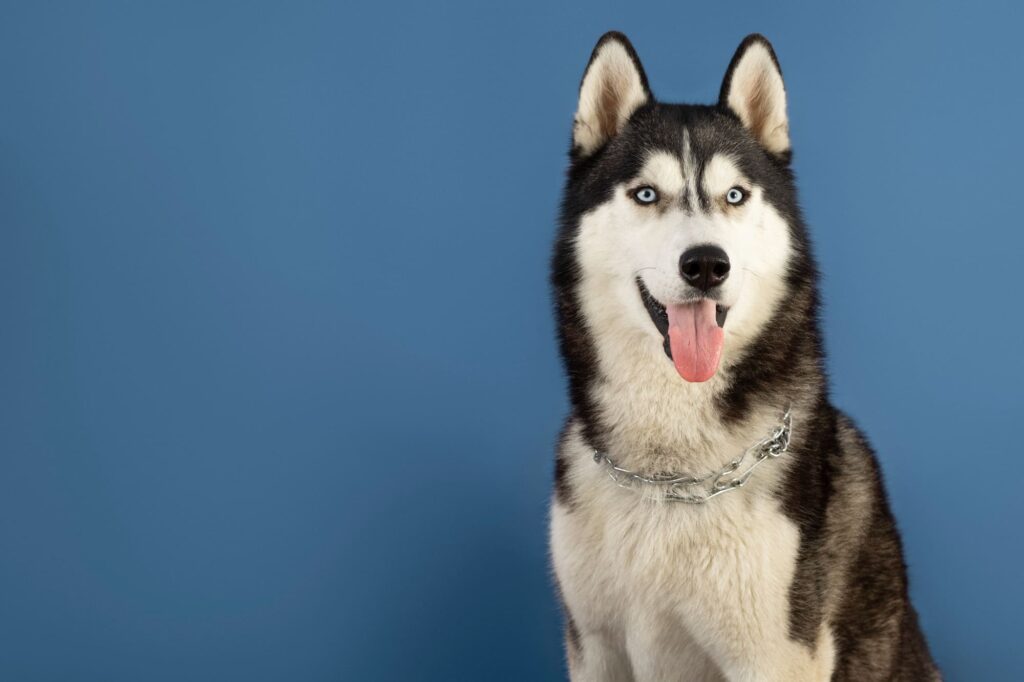
With their wolf-like looks, striking blue or brown eyes, and playful energy, Siberian Huskies are one of the most eye-catching dog breeds out there. But don’t let their fierce appearance fool you—they’re actually sweet, affectionate, and love spending time with their humans.
Where They Come From
Siberian Huskies were originally bred by the Chukchi people of northeastern Asia to pull sleds across snowy lands. They’re built for cold weather, long distances, and hard work. Today, Huskies still love running and make great pets for active families.
Personality & Temperament
Huskies are:
- Friendly and social
- Independent and smart
- Good with kids and other dogs
- Usually quiet, but can howl or “talk” when they want attention
They aren’t big on snuggling in your lap, but they love being near you, lying at your feet or nuzzling your side.
Smart but Stubborn
These dogs are super smart, but they also like to do their own thing. That means:
- They’re not the easiest to train, but they’re not impossible!
- Use positive reinforcement—praise, treats, and playtime work best
- Training takes patience and consistency
If you enjoy a challenge, a Husky will keep you on your toes—in the best way!
Exercise is a MUST
Huskies were made to run, and they still need lots of exercise today. Without it, they can get bored—and a bored Husky might:
- Chew up things
- Dig holes
- Try to escape the backyard
- Or start howling for fun!
Give your Husky:
- Daily long walks or runs
- Time off-leash in a fenced yard or dog park
- Games like fetch or hide-and-seek
If you’re active, a Husky will be your perfect adventure buddy.
Grooming That Fluffy Coat
Huskies have a thick double coat that helps keep them warm—but it also sheds a LOT, especially twice a year (called “blowing coat”).
Here’s what they need:
- Brush once a week most of the year
- Brush daily during shedding seasons (spring and fall)
- Use a rake-style brush to get through the undercoat
- No need for lots of baths—once every few months is usually enough
Size and Looks
Siberian Huskies are medium-sized dogs, usually weighing:
- 35 to 60 pounds
- 20 to 24 inches tall
They have:
- Pointy ears
- Curly tails
- Striking eyes—blue, brown, or even one of each!
- A soft, plush coat in colors like gray, red, black, or white
In Summary:
Siberian Huskies are smart, fun-loving, high-energy dogs that love being part of the family. They’re not lapdogs, but they are loyal, sweet, and always ready for adventure. With the right grooming and exercise, they’ll be a beautiful, exciting, and affectionate companion.
Just be prepared for a bit of hair—and a lot of zoomies!
9. Golden Retriever
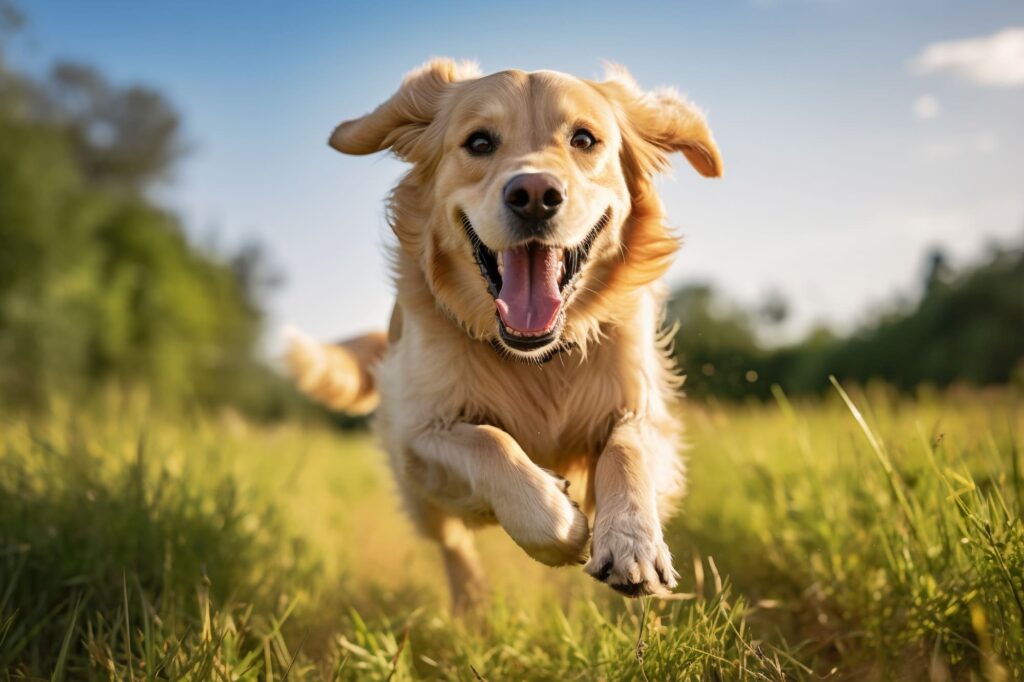
Golden Retrievers are one of the most popular family dogs in the world—and it’s easy to see why. These sweet, smart, and friendly dogs are always ready for a cuddle, a game of fetch, or a swim at the lake.
Where They Come From
Golden Retrievers were first bred in the Scottish Highlands in the 1800s to help hunters retrieve birds from land and water. That’s why they’re such great swimmers and love to carry things in their mouths—even your shoes!
Personality & Temperament
Golden Retrievers are:
- Friendly with everyone—kids, adults, other pets
- Eager to please and very obedient
- Gentle, affectionate, and loyal
- Great as therapy dogs, guide dogs, and in search-and-rescue work
They’re known for having a happy-go-lucky attitude, always wagging their tails and spreading joy wherever they go.
Playful and Energetic
Goldens have lots of energy and need:
- Daily exercise like long walks or backyard play
- Games like fetch, swimming, or tug-of-war
- Time to run and explore—these dogs love adventure!
They can get distracted during training because they’re so curious, but their love of pleasing people makes them fast learners with patience and positive reinforcement.
Grooming That Golden Coat
Golden Retrievers have a thick double coat that keeps them warm—but it also sheds!
Here’s how to care for it:
- Brush 2–3 times a week to remove loose hair and keep it soft
- Brush daily during shedding seasons (spring and fall)
- Trim long hairs every 8–10 weeks to keep them neat
- Bath every 1–2 months or when dirty
Their coats come in beautiful shades of light to dark golden, and with the right care, they stay soft and shiny year-round.
Size and Looks
Golden Retrievers are medium to large-sized dogs, typically:
- 55 to 75 pounds
- 21 to 24 inches tall
They have:
- Floppy ears
- A long, feathery tail
- Kind, expressive eyes
- A beautiful golden coat that gives them their name
In Summary:
Golden Retrievers are smart, loyal, and loving dogs that make wonderful companions for families, singles, and seniors alike. They’re active and social, but also happy to chill by your side. If you want a dog that’s gentle, playful, and full of heart, the Golden Retriever might just be your perfect match.
Just don’t forget to bring a tennis ball—they’ll be ready for a game anytime!
10. Tibetan Mastiff

If there’s one dog that looks like it walked straight out of a fairytale, it’s the Tibetan Mastiff. With its massive body, thick lion-like mane, and deep, watchful eyes, this dog is as majestic as it is powerful.
But don’t let that big, serious face fool you—Tibetan Mastiffs have a soft spot for their family and can be sweet, gentle cuddle buddies at home.
Ancient Origins
Tibetan Mastiffs are one of the oldest dog breeds in the world. They were first bred thousands of years ago in the Himalayan Mountains to protect livestock and property from wolves, leopards, and even snow leopards!
- Developed by nomadic herders in Tibet
- Bred to guard flocks and families
- Some Tibetans even believed these dogs had supernatural powers
Temperament: Calm, Loyal, Fiercely Protective
These dogs are:
- Loyal and affectionate with their families
- Naturally protective, making excellent guard dogs
- Independent thinkers (they make their own decisions)
- Quiet indoors but very aware of what’s happening around them
Tibetan Mastiffs can be stubborn. They’re smart enough to learn commands, but they’ll choose whether or not to listen. That’s why they do best with experienced owners who use kind, consistent training.
They don’t bark without reason, but when they do, their deep bark can scare off intruders—and even wild animals.
Grooming That Giant Coat
The Tibetan Mastiff’s coat is big, bold, and built for the cold. It has:
- A soft, wooly undercoat
- A thick, straight outer coat
- A giant mane (especially in males)
Grooming tips:
- Brush 2–3 times a week to prevent tangles
- Brush daily during shedding season (once a year they “blow out” their coat)
- Bath only when needed—they’re naturally clean dogs
- Keep cool in hot weather, as they overheat easily
Their fur might look like a handful, but with regular brushing, it’s totally manageable—and very snuggly.
Size and Strength
Tibetan Mastiffs are massive dogs, often:
- 26 inches tall or more
- Weigh 70–150 pounds
- Live 12–15 years with proper care
Their size alone makes them great protectors—but they’re also known for their calm and gentle nature at home.
In Summary:
The Tibetan Mastiff is like a living legend—a giant dog with ancient roots, a strong sense of loyalty, and a regal presence. They may be aloof with strangers, but they are loving and gentle with their families.
If you want a dog that brings both security and snuggles, and you’re ready for a little extra grooming and a lot of big love, the Tibetan Mastiff might just be your perfect match.
Just be ready—this is not a beginner dog. But for the right person, they’re an unforgettable best friend.
11. German Shepherd
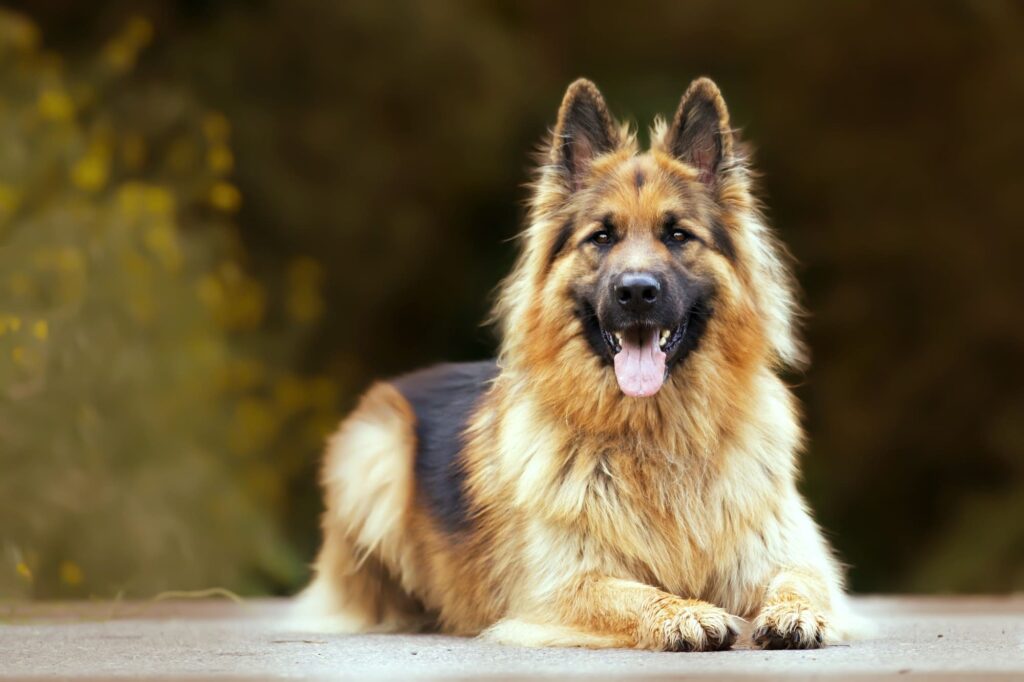
The German Shepherd is one of the most popular dog breeds in the world—and it’s easy to see why. These dogs are smart, brave, and deeply loyal to their families. But there’s another side to them that people don’t always talk about: they love to cuddle.
Yes, this hardworking dog has a soft, loving side, and when they bond with you, they’ll want to stay close.
Smart, Brave, and Loving
German Shepherds are known for:
- High intelligence—they learn fast!
- Strong loyalty—they form close bonds
- Courage—they’ll protect you without hesitation
- Gentle nature at home—especially with kids and other pets
Because of these traits, German Shepherds are often chosen for important jobs:
- Police and military work
- Search and rescue missions
- Service dogs for people with disabilities
But at home? They’re just steady, affectionate companions who love being part of the family.
Cuddle Factor: Higher Than You Think
While they might not look as fluffy as some breeds like the Golden Retriever or Saint Bernard, German Shepherds have:
- A thick double coat that’s soft to the touch
- A strong desire to be close to their people
Their loyalty makes them natural snuggle buddies, especially when they feel safe and relaxed.
Grooming and Shedding
German Shepherds shed a lot, especially when seasons change. Their coat:
- Has a soft undercoat and a coarser outer coat
- Sheds year-round, with heavy shedding in spring and fall
- Needs to be brushed 3–4 times a week to control loose fur
💡 Tip: A regular brushing routine not only helps with shedding, but also keeps their coat healthy and gives you time to bond.
Size and Strength
German Shepherds are medium to large-sized dogs. Most:
- Weigh between 60–90 pounds
- Stand 22–26 inches tall at the shoulder
- Live about 9–13 years
They’re athletic and strong, so they need regular exercise—walks, playtime, or even learning tricks to keep their mind and body active.
In Summary:
The German Shepherd is the total package: intelligent, protective, affectionate, and loyal to the core. They thrive in homes where they can be close to their people and given a job to do—even if that job is just playing fetch in the yard.
They may look tough, but they’re full of love—and once they bond with you, they’ll always be by your side.
12. Alaskan Malamute
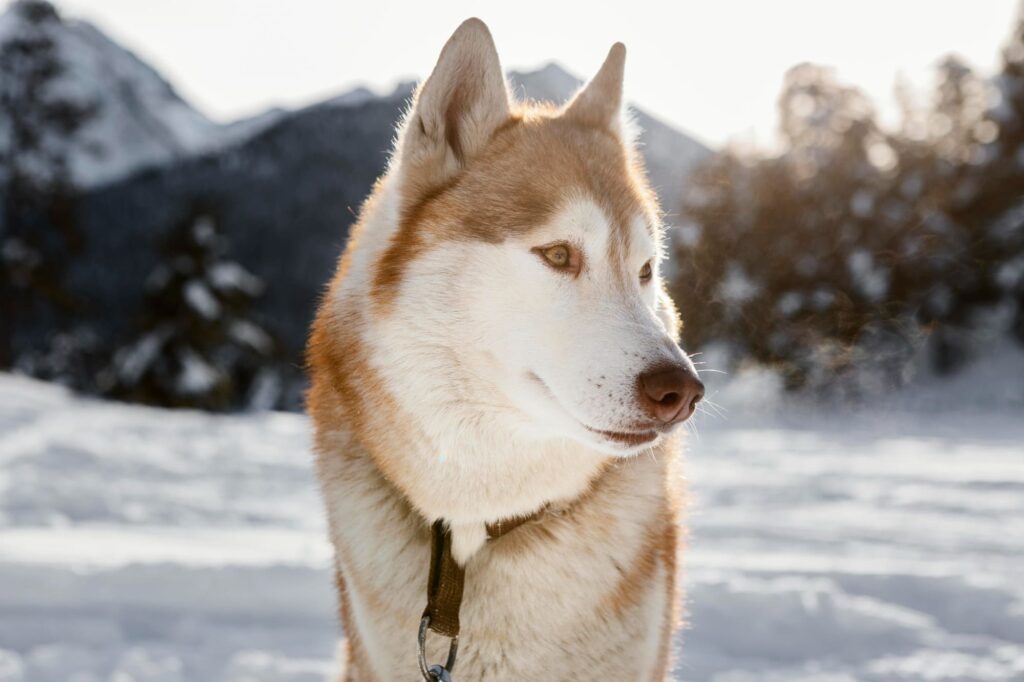
With a look that’s part wolf, part teddy bear, the Alaskan Malamute is one of the fluffiest and strongest dog breeds around. These powerful pups were built to pull sleds across snowy lands, but don’t let their strength fool you—they’re also sweet, cuddly, and love being part of the family.
A Wolf-Like Past, A Loving Heart
The Alaskan Malamute gets its name—and its thick coat—from the Mahlemut tribe in Alaska. These dogs have a long history:
- Descended from domesticated dogs that crossed the Bering Strait over 4,000 years ago
- Bred to hunt, haul heavy loads, and protect families from Arctic predators
- Used to scare off polar bears—yes, really!
But today? They’re more likely to snuggle on your couch than battle a bear.
Smart, Loyal, and Independent
Malamutes are:
- Highly intelligent, but also independent thinkers
- Friendly and affectionate, especially with their humans
- Great with kids, though they do best with experienced dog owners
These dogs are loyal and love being part of the pack—but they also enjoy doing things their own way. Training should be firm but gentle (no yelling!), and they thrive with structure and clear boundaries.
Cuddle Factor: 10/10
If you love big dogs that feel like giant fluffy pillows, this breed is for you. Their thick, luxurious coat:
- Keeps them warm in the coldest places on Earth
- Makes them perfect snuggle buddies—especially after a day of play
Malamutes bond closely with their people and love relaxing with the family at night, even if they spent the day hauling sleds or running around the yard.
Grooming and Shedding
Here’s the deal: Alaskan Malamutes shed. A lot. Especially during spring and fall.
Their coat:
- Has two layers: a soft undercoat and a coarse top coat
- Sheds heavily, also known as “blowing their coat”
- Needs daily brushing to prevent mats and hot spots
Tools you’ll need: A pin brush and metal comb work best to keep their fur clean and tangle-free.
💡 Pro Tip: Brush daily and vacuum often—this isn’t the dog for neat freaks!
Size and Strength
Alaskan Malamutes are big and powerful. Most:
- Weigh 75–100 pounds or more
- Stand 23–25 inches tall at the shoulder
- Live about 10–14 years
They’re bred for endurance, so they need plenty of exercise—long walks, hikes, and outdoor adventures are perfect.
Are They Right for You?
Alaskan Malamutes are best for:
- Active families who enjoy outdoor fun
- People who have time for grooming
- Owners with experience handling strong-willed dogs
They’re not ideal for hot climates (they can overheat easily), and they need room to roam—not a great match for small apartments.
In Summary:
The Alaskan Malamute is a majestic, strong, and loving companion. With their history rooted deep in the Arctic, these dogs bring both adventure and affection to any home. Just be ready for lots of brushing, daily exercise, and a little bit of stubbornness—all worth it for a dog that will protect you, play with you, and cuddle up at the end of the day like the gentle giant they are.
13. Akita
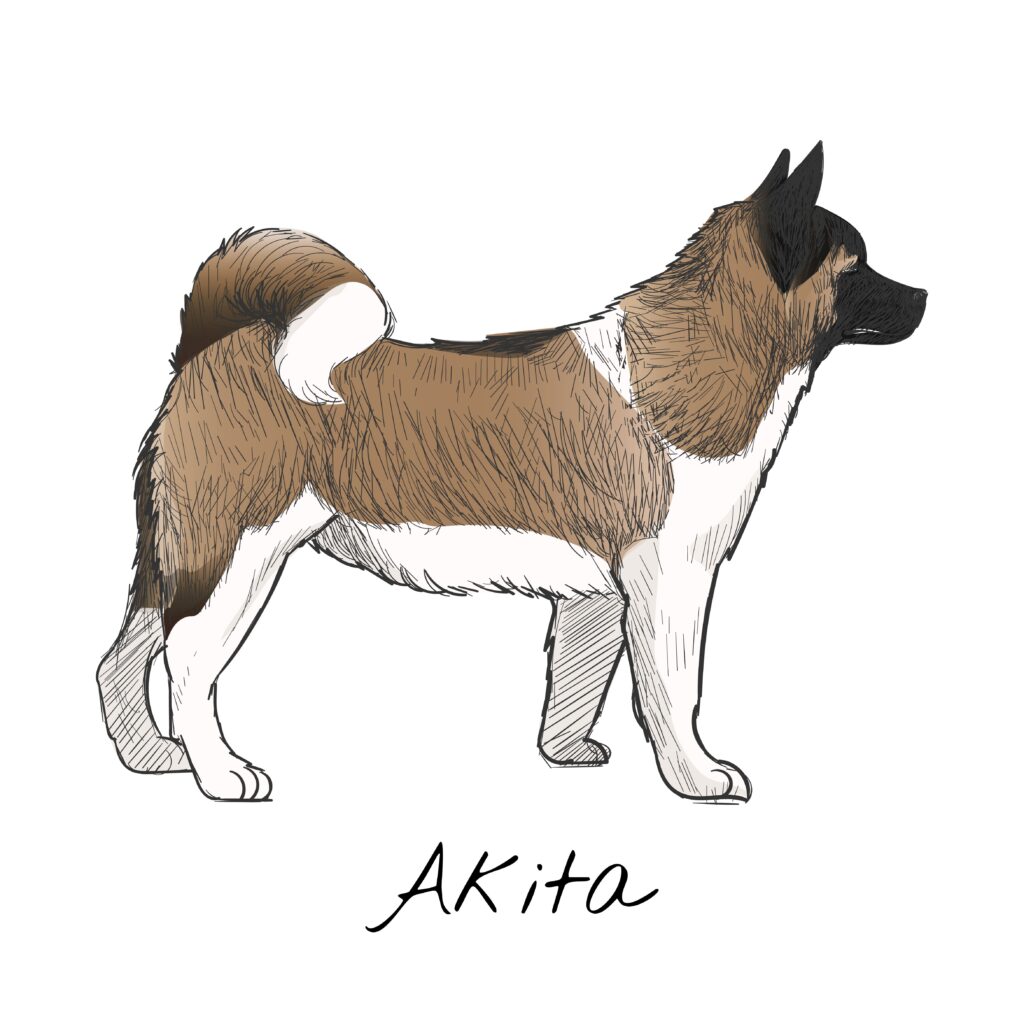
The Akita is a dog of power, pride, and deep loyalty. Originally from Japan, this breed is known for its quiet strength and noble appearance, but don’t let their serious face fool you—they’re total softies when it comes to the people they love.
A Noble History
Akitas have a long and important history in Japan:
- They were bred to guard royalty and hunt big game, like bears and wild boar.
- In Japan, they are a symbol of protection, good health, and happiness.
- One famous Akita, Hachikō, became a national hero for waiting at a train station every day for his owner—even after the owner passed away.
Fun fact: Helen Keller brought the first Akita to the U.S. in the 1930s!
Loyal, Brave, and Independent
Akitas are:
- Very loyal—they bond deeply with their family
- Protective and courageous—they’re natural guard dogs
- Independent and strong-willed, which means they need a confident owner who knows how to train dogs
They’re not the best fit for first-time dog owners or homes with lots of other pets. But if you want a devoted companion, the Akita will stand by your side for life.
Cuddle Factor: 9/10
Akitas look like giant plush toys, thanks to their thick, soft coats and curled tails. They’re:
- Calm and quiet indoors
- Very loving with their people
- Big fans of snuggling—on their own terms, of course!
They may be aloof with strangers and don’t always get along with other dogs, but their family? They adore them.
Grooming Needs
That fluffy coat doesn’t maintain itself! The Akita’s double coat:
- Sheds lightly most of the year
- Sheds heavily twice a year (called “blowing their coat”), when it comes out in clumps
- Needs weekly brushing—but during shedding season, brush daily
💡 Use a slicker brush and undercoat rake to keep their fur clean and mat-free.
Size and Strength
Akitas are big, strong dogs:
- Males can weigh 100–130 pounds
- Females usually weigh 70–100 pounds
- They stand 24–28 inches tall at the shoulder
They need daily walks and playtime, but they’re not hyper. A big fenced yard is great—but they’ll be happy lounging near you indoors, too.
Who Should Own an Akita?
Akitas are best for:
- Experienced dog owners
- Families without small pets or multiple dogs
- People who want a loyal, protective, and calm companion
They’re not ideal for dog parks or chaotic households. These dogs thrive in homes where they’re respected and loved, with consistent rules and routines.
In Summary:
The Akita is a loyal protector with a heart of gold. With their strong spirit, soft coat, and deep bond with family, they’re the perfect mix of guard dog and gentle giant. Just be ready for some heavy shedding twice a year—and a dog that’s as dignified as it is fluffy.
14. Chow Chow
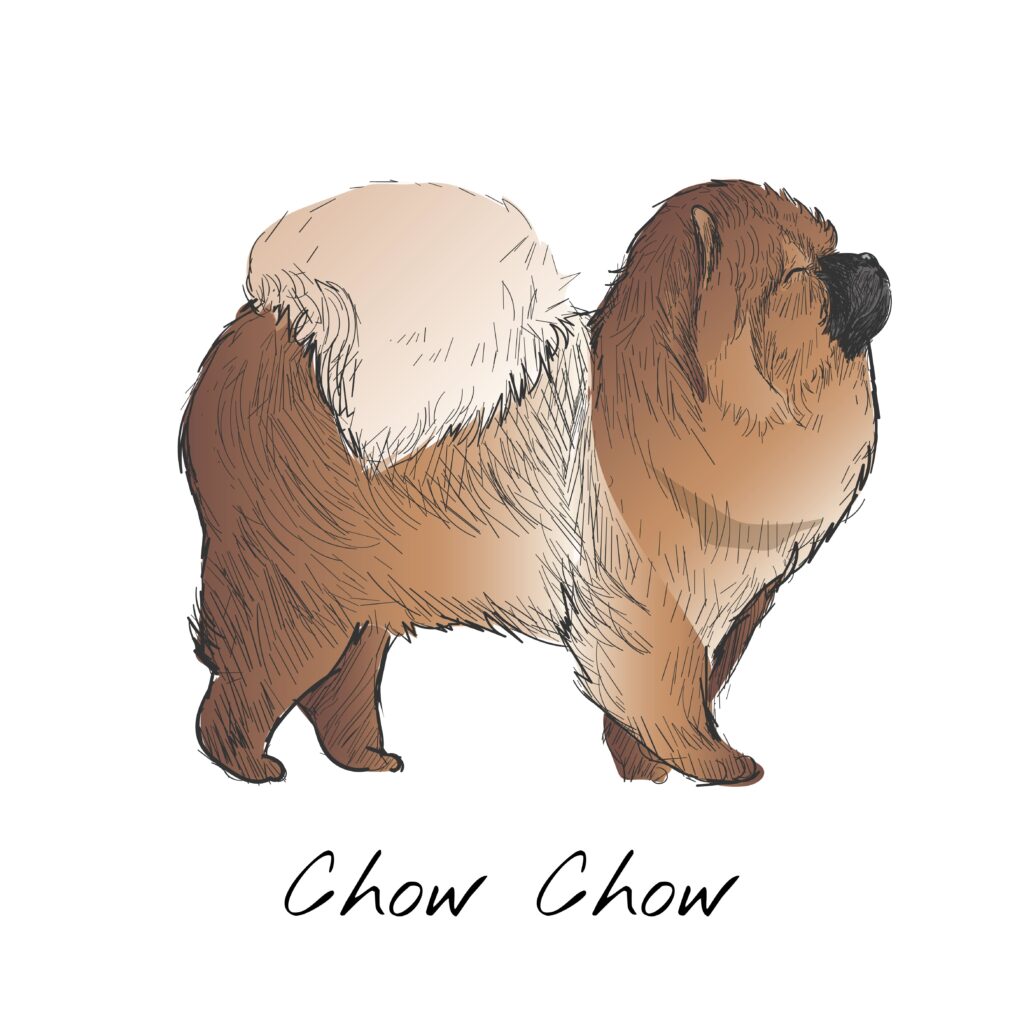
The Chow Chow is a dog like no other. With its lion-like mane, teddy bear body, and blue-black tongue, this ancient breed stands out wherever it goes. Aloof but loyal, fluffy but dignified—Chow Chows are walking contradictions in the best way.
A Breed with Ancient Roots
The Chow Chow comes from China, where they were:
- Used as guard dogs, hunters, and sled pullers
- Kept by emperors and nobles as companions
- One of the oldest dog breeds in the world
Their name may sound cute, but these dogs have a proud and powerful history.
Personality: Independent But Loyal
Chow Chows are:
- Aloof with strangers—they won’t greet everyone like a Golden Retriever
- Devoted to their family—once they bond with you, they’ll stay close
- Quiet and calm indoors—they love lounging beside their humans
- Naturally protective, which makes them good watchdogs
They aren’t super cuddly, but they do enjoy your company—on their terms.
Cuddle Factor: 7/10
Chows may look like oversized teddy bears, but they’re a bit reserved. Still, their thick coat and sturdy frame make them cozy companions when they choose to snuggle.
They’re not needy, but they’ll quietly keep watch near your side, offering comfort without clinginess.
Grooming Needs
That fluffy coat is beautiful—but it needs work:
- Brush 2–3 times a week to prevent mats and tangles
- Watch out for shedding, especially during seasonal changes
- Pay close attention to their eyes, ears, and skin folds, which can trap dirt
💡 Use a slicker brush and metal comb, and plan for regular grooming sessions to keep that mane looking regal.
Size and Strength
Chow Chows are solid, medium-sized dogs:
- Height: 17–20 inches at the shoulder
- Weight: 45–70 pounds
- Sturdy, square build with a distinctive stilted walk
They carry themselves with confidence and grace, almost like royalty.
Training & Socialization
Chow Chows are smart—but also independent. That means:
- They can be stubborn
- Need early socialization to be friendly with people and pets
- Respond best to firm but gentle training
Start early and stay consistent. The result? A calm, well-mannered companion.
Who Should Own a Chow Chow?
This breed is perfect for:
- Owners who want a quiet, low-energy dog
- Families with older children
- People who appreciate a watchful, independent companion
They’re not ideal for first-time dog owners or homes with lots of chaos or small pets.
In Summary
The Chow Chow is like a fluffy guardian with the heart of a lion. While not the most affectionate at first, they’re loyal, protective, and incredibly dignified. With their iconic look and low-key personality, they make majestic companions for the right home.
15. Leonberger

If you’ve ever dreamed of hugging a lion-sized teddy bear, meet the Leonberger. With their soulful eyes, massive frame, and ultra-soft coat, these gentle giants are loyal, loving, and perfect family companions. Originally bred for work but built for cuddles, the Leo is as majestic as they come.
🇩🇪 A Breed with a Noble Heritage
Leonbergers come from Leonberg, Germany, where they were created by crossing:
- Saint Bernards
- Great Pyrenees
- Newfoundlands
The goal? To design a dog that resembled a lion, with the temperament of a companion and the strength of a working dog. Mission accomplished.
Cuddle Factor: 10/10
Leos don’t just look like teddy bears—they act like them, too. They’re:
- Exceptionally affectionate with family
- Great with kids and other pets
- Calm, patient, and eager to please
When they’re not romping outside, you’ll find them curled up near your feet—or trying to sit in your lap.
Personality & Temperament
Leonbergers are:
- Gentle and good-natured
- Playful and friendly, without being hyper
- Loyal guardians, yet rarely aggressive
They have a strong protective instinct, so early training and socialization are key to raising a well-mannered Leo. They can be wary of strangers and other dogs—especially untrained males—so consistent leadership matters.
Grooming: Daily Brushing Required
With a thick double coat and natural water resistance, grooming a Leonberger is a serious commitment:
- Daily brushing helps prevent tangles and mats
- Use 3–4 grooming tools (undercoat rake, slicker brush, dematter, metal comb)
- Expect year-round shedding, with massive blowouts twice a year
- Minimal bathing needed thanks to their natural skin oils
🛁 Pro Tip: Weekly ear cleaning and nail trims are just as important!
Size & Strength
Leonbergers are massive and muscular:
- Males: Up to 170 pounds
- Females: Usually 110–140 pounds
- Height: 25.5–31.5 inches at the shoulder
Their size demands plenty of space, a strong handler, and regular exercise to stay mentally and physically balanced.
Born to Work (and Play)
Leonbergers thrive when they have a job to do:
- Great for cart pulling, water rescue, and therapy work
- Excellent hiking buddies and outdoor explorers
- Need at least an hour of exercise daily
Without activity, they can become bored and destructive—so keep them busy and involved in family life
Smart, Trainable & Sensitive
This breed is intelligent and eager to please, but also a bit sensitive. That means:
- Positive reinforcement works best
- Harsh training can shut them down
- Socialization from an early age is essential
When raised with care, Leos become confident, balanced dogs with a gentle spirit and a lion’s loyalty.
Who Should Own a Leonberger?
Ideal for:
- Active families with large living spaces
- Owners willing to groom daily
- People who want a gentle, calm dog with strong protective instincts
Not ideal for:
- Apartment living
- People allergic to dog hair
- Those unable to handle a giant breed’s strength and needs
In Summary
The Leonberger is a regal, affectionate giant who thrives on companionship, purpose, and plenty of grooming time. They may be high-maintenance in the brush department, but they give back tenfold in love, loyalty, and gentle strength. If you want a dog that’s part lion, part lifeguard, part snuggle buddy—this might be your perfect match.
16. Rough Collie
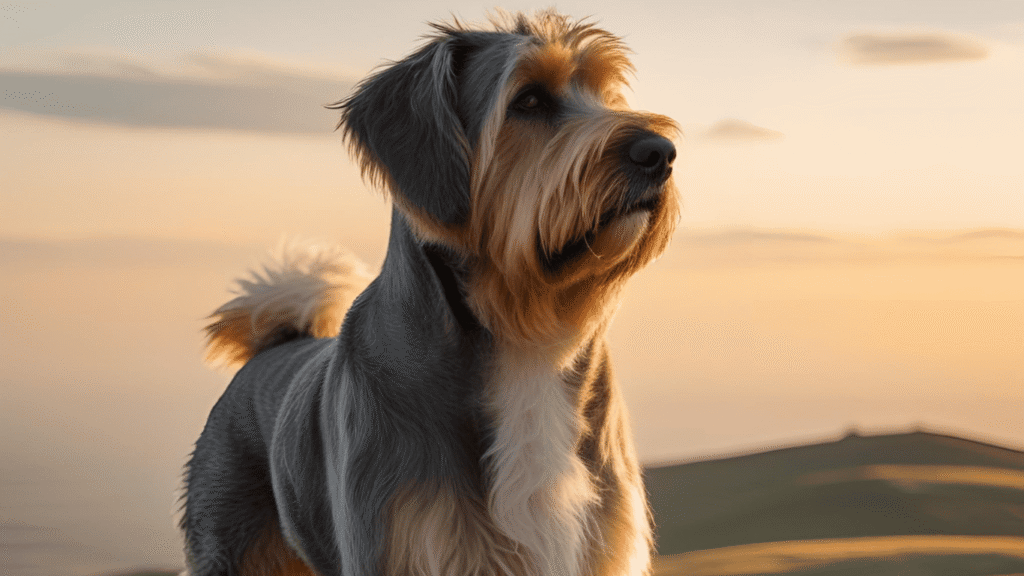
Forever etched in our minds as Lassie, the Rough Collie is more than just a movie star. With a regal stance, soulful eyes, and a flowing double coat, this herding breed is beauty, brains, and loyalty all wrapped up in one elegant dog.
A Scottish Icon with Hollywood Fame
Originally bred in Scotland as a hardworking herding dog, the Rough Collie skyrocketed to fame thanks to the classic Lassie TV and movie series. But in real life, these dogs are just as heroic and loyal as their on-screen counterpart.
Intelligent, Sensitive, and Family-Oriented
Rough Collies are:
- Highly intelligent and easy to train
- Gentle with kids and great with families
- Naturally protective, yet rarely aggressive
- Excellent at reading their owners’ emotions
They thrive on human connection, making them one of the most loyal and emotionally intuitive breeds around.
Grooming Needs: Luxurious, But Manageable
That stunning long coat does need some love:
- Brush 2–3 times per week to prevent mats and tangles
- Weekly brushing is often enough for maintenance in non-shedding seasons
- Expect seasonal shedding twice a year (“coat blow”)
✂️ Bonus Tip: Pay attention to feathering on legs and tail—they’re prone to knots!
Exercise & Energy Levels
Though elegant, the Rough Collie isn’t just a couch ornament. They need:
- At least an hour of activity daily
- Playtime, walks, or even herding games to stay sharp and satisfied
- A fenced yard or safe space to run is ideal
This breed was built to move—let them stretch those long legs and feel the breeze ripple through their fur.
Best For:
Rough Collies are ideal for:
- Families with children of all ages
- First-time dog owners who want a loyal, trainable breed
- People who want a dog that’s both elegant and emotionally intuitive
- Homes with enough time for regular grooming and daily exercise
They’re not suited for:
- People looking for a low-shedding breed
- Those with little time for interaction—Collies crave companionship
Personality Snapshot
| Trait | Rating |
| Intelligence | ⭐⭐⭐⭐⭐ |
| Trainability | ⭐⭐⭐⭐⭐ |
| Shedding | ⭐⭐⭐⭐☆ |
| Grooming Needs | ⭐⭐⭐⭐☆ |
| Energy Level | ⭐⭐⭐⭐☆ |
| Kid-Friendliness | ⭐⭐⭐⭐⭐ |
| Watchdog Ability | ⭐⭐⭐⭐☆ |
Fun Fact: Not Just a Pretty Face
Rough Collies have long been used as therapy and service dogs thanks to their empathy, calm demeanor, and quick learning ability. They don’t just look heroic—they act like it too.
Final Thoughts
With their striking good looks, high emotional intelligence, and deep devotion, Rough Collies are much more than Lassie’s legacy. They’re loyal family dogs, intuitive protectors, and graceful athletes who want nothing more than to love and be loved.
17. Standard Poodle
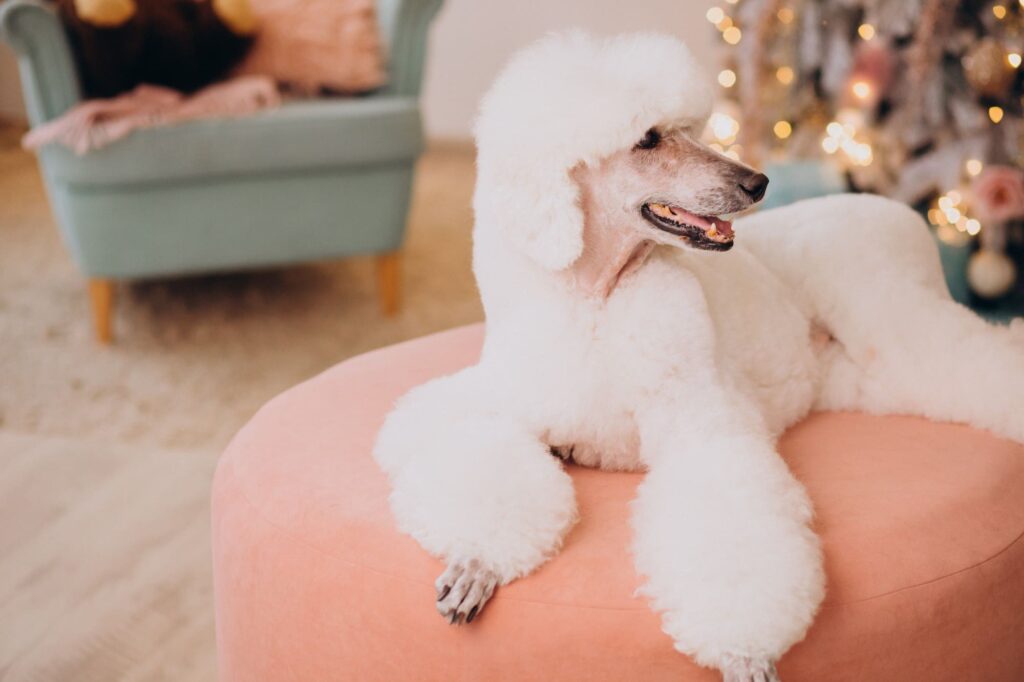
Often flying under the radar in the “fluffy dog” world, the Standard Poodle is elegance, intelligence, and athleticism all rolled into one. With their hypoallergenic curls, regal posture, and high IQ, these dogs are so much more than just a pretty face.
Beauty and Brains
The Standard Poodle isn’t just one of the smartest dog breeds on the planet—they’re also:
- Playful and gentle with children
- Eager to please, making training a breeze
- Natural athletes who excel in obedience, agility, and water sports
- Incredibly emotionally intuitive, often used as therapy or service dogs
Hypoallergenic Curls with High-Maintenance Needs
That iconic coat? It’s as functional as it is fashionable:
- Curly, non-shedding, and hypoallergenic—great for allergy sufferers
- But it requires consistent care:
- Daily brushing to prevent mats
- Professional grooming every 4–6 weeks to keep those curls neat and healthy
- Daily brushing to prevent mats
- Neglected coats will mat down to the skin, which is uncomfortable and difficult to fix
✂️ Pro Tip: Keep coats clipped short if you’re not up for the high fluff-maintenance.
Exercise & Activity
Despite their fancy looks, Standard Poodles are true athletes:
- They need at least an hour of exercise per day
- Activities like fetch, swimming, running, or agility courses keep them happy
- Mental stimulation is just as important as physical—these dogs love a challenge
Sizes & Stats
- Weight: Up to 70+ pounds
- Height: Over 15 inches (Standard size)
- Lifespan: 12–15 years
- Colors: White, black, apricot, gray, brown, and more
- Coat Type: Curly, dense, single-layered
Best For:
Standard Poodles thrive in homes that offer:
- Consistent grooming routines
- Daily physical and mental stimulation
- Lots of human interaction—they don’t like being left alone too long
- Allergy-sensitive family members looking for a low-shedding dog
They are great with kids, other dogs, and adapt well to city or suburban life, as long as their exercise needs are met.
Personality Snapshot
| Trait | Rating |
| Intelligence | ⭐⭐⭐⭐⭐ |
| Trainability | ⭐⭐⭐⭐⭐ |
| Grooming Needs | ⭐⭐⭐⭐⭐ |
| Shedding | ⭐☆☆☆☆ |
| Energy Level | ⭐⭐⭐⭐☆ |
| Kid-Friendliness | ⭐⭐⭐⭐⭐ |
| Allergy-Friendly | ⭐⭐⭐⭐⭐ |
Final Thoughts
Don’t be fooled by their prim-and-proper appearance. The Standard Poodle is a smart, sensitive, and sporty companion wrapped in curly, cloud-like fur. For the right owner, they’re the perfect combination of fluff and finesse—a hypoallergenic hero with a heart of gold.
18. Eurasier
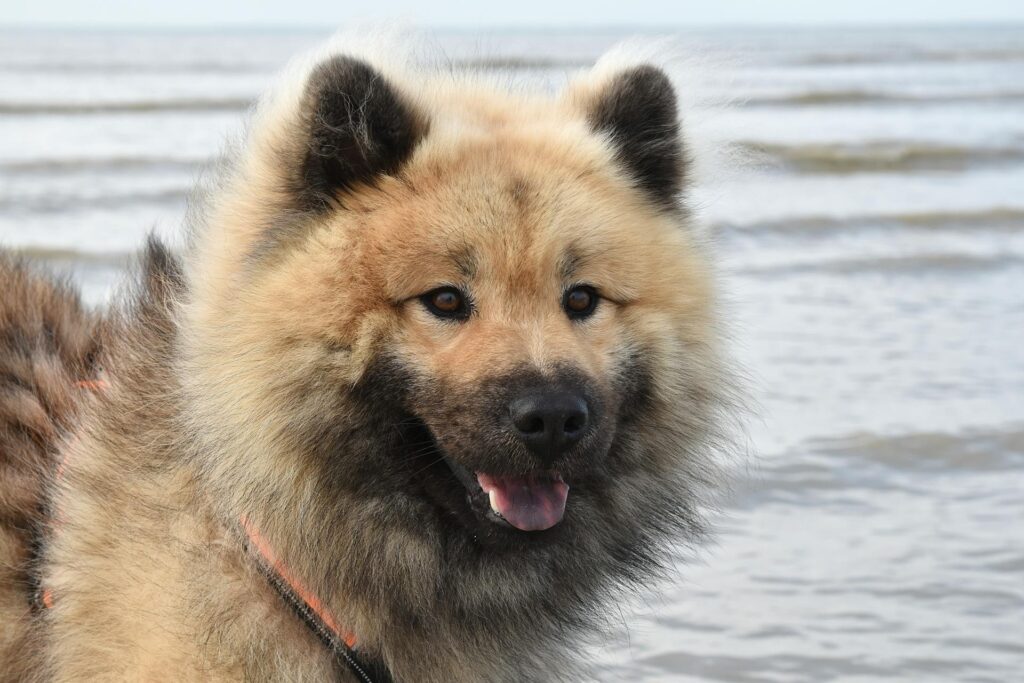
A blend of Chow Chow, Keeshond, and Samoyed, the Eurasier is a dignified yet deeply affectionate breed with a fox-like face and a plush double coat that practically invites cuddles. Calm, balanced, and strikingly beautiful, this medium-large dog is one of the best-kept secrets in the fluffy dog world.
A Noble Heritage
Developed in Germany as a companion dog, the Eurasier’s name honors its European and Asian roots. This intentional mix was bred for:
- Loyal companionship
- Gentle temperament
- Striking good looks
Thanks to its thoughtful breeding, the Eurasier is known for:
- Quiet confidence
- Strong family bonds
- Low reactivity—they rarely bark unnecessarily
Personality & Temperament
Eurasiers are known for being:
- Calm and level-headed
- Extremely devoted to their family
- Gentle with children
- Reserved but polite with strangers
They don’t do well when isolated or left alone for long periods—these dogs are people-oriented and thrive on closeness with their humans.
Grooming Needs
That majestic coat is thick and plush, but surprisingly manageable:
| Grooming Task | Frequency |
| Brushing | 1–2 times/week |
| Bathing | Once per month |
| Seasonal Shedding | Heavily, twice/year (spring & fall) |
During seasonal sheds (aka “blowouts”), daily brushing will help control loose fur and prevent matting.
Exercise & Training
The Eurasier is moderately active and benefits from:
- Daily walks and play sessions
- Mental stimulation like puzzle toys or training games
- Positive reinforcement training—they’re smart and eager to learn, but don’t respond well to harsh discipline
They aren’t hyper, but they do enjoy family activities, hikes, and sniffing around the backyard.
Breed Stats
- Size: Medium–Large
- Weight: 40–70 pounds
- Height: 19–24 inches
- Coat Type: Thick double coat
- Lifespan: 12–14 years
- Colors: Red, black, fawn, wolf-gray, sable, and combinations (except white or liver)
Best For:
| Ideal Home Type | Why They’re a Match |
| Calm households | Their peaceful nature thrives in low-drama environments |
| Families with kids | They’re gentle and protective |
| People who work from home | Eurasiers crave human connection |
| Fluffy dog lovers | That coat is next-level cuddly |
Final Thoughts
The Eurasier is everything you want in a fluffy companion—gorgeous, intelligent, and emotionally in tune. While they aren’t as well-known as other breeds, those who discover them quickly fall in love with their serene energy and fierce loyalty.
If you’re looking for a low-maintenance beauty with a big heart, the Eurasier just might be your perfect match.
19. Keeshond
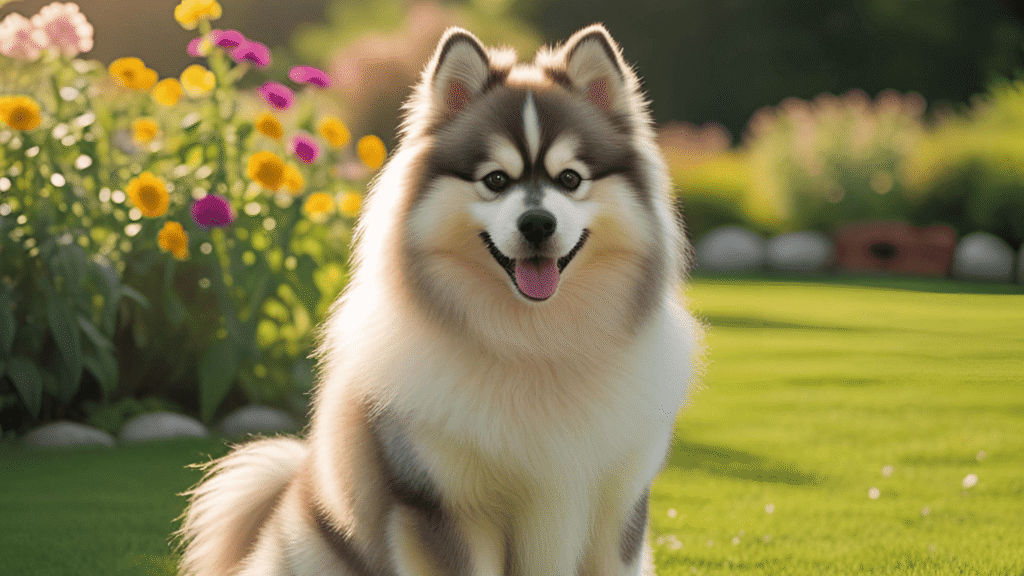
The Keeshond (pronounced KAYZ-hawnd) is a cheerful, cloud-like companion with a fox-like face and signature “spectacles”—dark markings around its eyes that make it look like it’s always wearing glasses (and maybe judging your snack choices).
Small-to-medium in size, yet big on charm, the Keeshond is an outgoing, affectionate dog that thrives in both apartments and family homes.
A Rich History
Originating in the Netherlands, the Keeshond served as a watchdog on riverboats, barges, and farms. Its thick, fluffy coat provided warmth and weather protection, making it a working dog in disguise.
Despite its historical roots as a barge dog, today’s Keeshond is more likely to guard your couch than your cargo—but it’s just as loyal.
Personality & Temperament
The Keeshond is:
- Extremely friendly and sociable
- Alert but not aggressive
- A natural people-pleaser that bonds tightly with its family
- Excellent with children and other pets
These dogs have a joyful spirit and love being part of the action—whether it’s a walk around the block or a binge-watching session on the sofa.
Grooming Needs
While their coat is plush and eye-catching, the Keeshond’s grooming needs are fairly manageable:
| Grooming Task | Frequency |
| Brushing | Weekly (more during seasonal shedding) |
| Bathing | Every 4–6 weeks or as needed |
| Shedding | Moderate year-round; heavy twice a year |
Their double coat naturally repels dirt and requires no trimming—just regular brushing to keep them tangle-free and fabulous.
Exercise & Training
Keeshonds are moderately active, needing:
- Daily walks
- Short play sessions
- Mental stimulation (they’re smart and quick to learn)
They’re not hyper, so they adapt well to apartment life, especially with regular activity and lots of attention.
Breed Stats
- Size: Small–Medium
- Weight: 35–45 pounds
- Height: 17–18 inches
- Coat Type: Thick double coat
- Lifespan: 12–15 years
- Colors: Silver-gray with black tips and cream undercoat
Best For:
| Ideal Home Type | Why They’re a Match |
| Apartment dwellers | Compact size and moderate energy level |
| First-time dog owners | Easygoing and eager to please |
| Families with kids | Naturally gentle and sociable |
| People who love expressive dogs | Those “glasses” are iconic |
Final Thoughts
The Keeshond is a people-focused fluffball with a permanent smile and a heart of gold. Whether you’re a seasoned dog lover or a first-timer, this breed offers the perfect mix of low-maintenance charm, intelligence, and cuddly companionship.
Plus, who can resist a dog that always looks like it’s ready for a Zoom call?
20. Belgian Sheepdog (Groenendael)

With its flowing black coat, alert stance, and piercing eyes, the Belgian Sheepdog, also known as the Groenendael, is a sleek yet fluffy herding dog that brings both beauty and brains to the table.
Originally bred for herding sheep and guarding property, this breed is loyal, watchful, and always ready for action.
Breed Overview
The Belgian Sheepdog is:
- Highly intelligent and responsive
- Naturally protective of its people
- Very energetic, needing both mental and physical stimulation
- Intensely loyal—they thrive on human companionship
They’re the kind of dog that watches your every move, eager to help, play, or alert you to a squirrel three blocks away.
Grooming Needs
Though the luxurious black double coat is stunning, it does come with upkeep:
| Grooming Task | Frequency |
| Brushing | 2–3 times per week (daily during shedding season) |
| Bathing | Every 6–8 weeks or as needed |
| Shedding | Moderate to heavy, especially in spring and fall |
Their coat is long, straight, and feathered—especially around the tail, legs, and neck—so regular brushing helps prevent tangles and mats.
Exercise & Training
Belgian Sheepdogs are working dogs through and through. They need:
- At least an hour of vigorous exercise daily
- Mental challenges (obedience training, agility, scent work, etc.)
- A job to do—even if it’s just keeping an eye on the backyard
Without enough stimulation, they may become bored or anxious, leading to problem behaviors.
Training should be:
- Consistent and positive
- Started early—this breed is smart and sensitive
- Focused on structure and challenge
Breed Stats
- Size: Medium–Large
- Weight: 60–75 pounds (males), 45–60 pounds (females)
- Height: 22–26 inches
- Coat Type: Long, straight double coat
- Lifespan: 12–14 years
- Color: Always black, occasionally with small white markings
Best For:
| Ideal Home Type | Why They’re a Match |
| Active families or individuals | This breed loves movement and mental work |
| Experienced dog owners | Requires consistent training and socialization |
| Homes with yards | Great watchdog instincts and energy to burn |
| People wanting a devoted companion | Forms a deep bond and is fiercely loyal |
Final Thoughts
The Belgian Sheepdog is a graceful protector, an eager learner, and a striking companion for anyone who can match its drive and devotion. With proper training and attention, they become not just pets—but partners.
If you’re ready for a dog that combines guardian instincts, athletic ability, and show-stopping good looks, the Groenendael might be your perfect match.
21. Briard
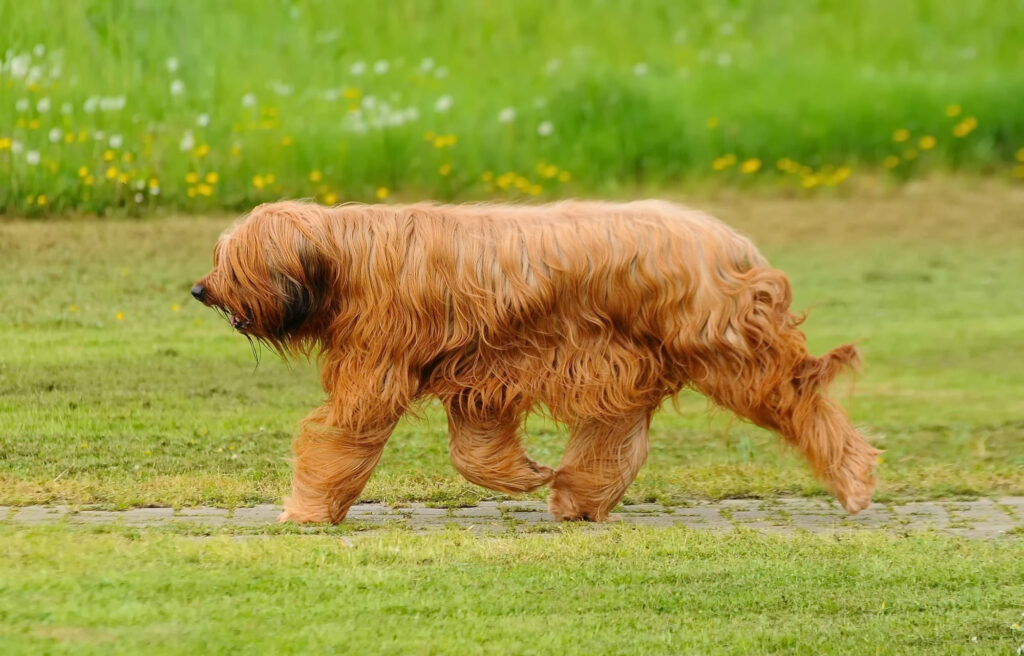
More than just a mop of fur with a nose—the Briard is a time-tested herding and guardian dog that has been working alongside shepherds in northern France for over a thousand years. This ancient breed is known for its brilliance, bravery, and boundless work ethic.
Don’t let the tousled look fool you—behind all that fluff is a seriously smart and loyal dog who thrives when given purpose and partnership.
Personality Snapshot
Briards are:
- Loyal and protective of their family
- Naturally alert and brave—with strong watchdog instincts
- Energetic and clever, always ready for training or a job
- Known for their gentle nature with children when socialized early
They’re herding dogs at heart, so they might try to herd kids, other pets, or even guests—just something to keep in mind!
Grooming Needs
This breed’s long, wavy double coat is stunning but requires serious grooming commitment.
| Grooming Task | Frequency |
| Brushing | 2–3 times per week (daily preferred) |
| Tools Needed | Pin brush, undercoat rake |
| Bathing | Monthly or as needed |
| Shedding | Moderate (heavier in spring/fall) |
Failing to brush thoroughly down to the skin can lead to painful mats. Routine coat care also keeps shedding under control and helps preserve that show-stopping silhouette.
Exercise & Training
Briards need daily physical and mental exercise. They were bred to work, and that instinct still runs deep.
They love:
- Structured training sessions
- Herding, agility, or obedience activities
- Long walks, hikes, or backyard play
Early training and socialization are essential. This breed is smart and eager to please—but also strong-willed, so a confident, consistent handler is best.
Breed Stats
- Size: Large
- Weight: 55–100 pounds
- Height: 22–27 inches
- Coat Type: Long, slightly wavy double coat
- Lifespan: 10–12 years
- Colors: Black, fawn, gray, or tawny
Best For:
| Ideal Home Type | Why They’re a Match |
| Active families or individuals | Briards need daily exercise and mental tasks |
| Homes with space | Their size and energy need room to roam |
| Experienced dog owners | Training a strong-willed herding dog takes skill |
| People who enjoy grooming | That shaggy coat doesn’t care for itself |
Final Thoughts
The Briard is a bold, brilliant, and beautiful working dog with a heart of gold. Whether helping herd sheep or playing protector at home, this French classic brings both charm and muscle to the table.
For those who can keep up with their grooming and give them a job, the Briard offers loyalty, smarts, and serious fluff appeal in one unforgettable package.
22.Bouvier des Flandres
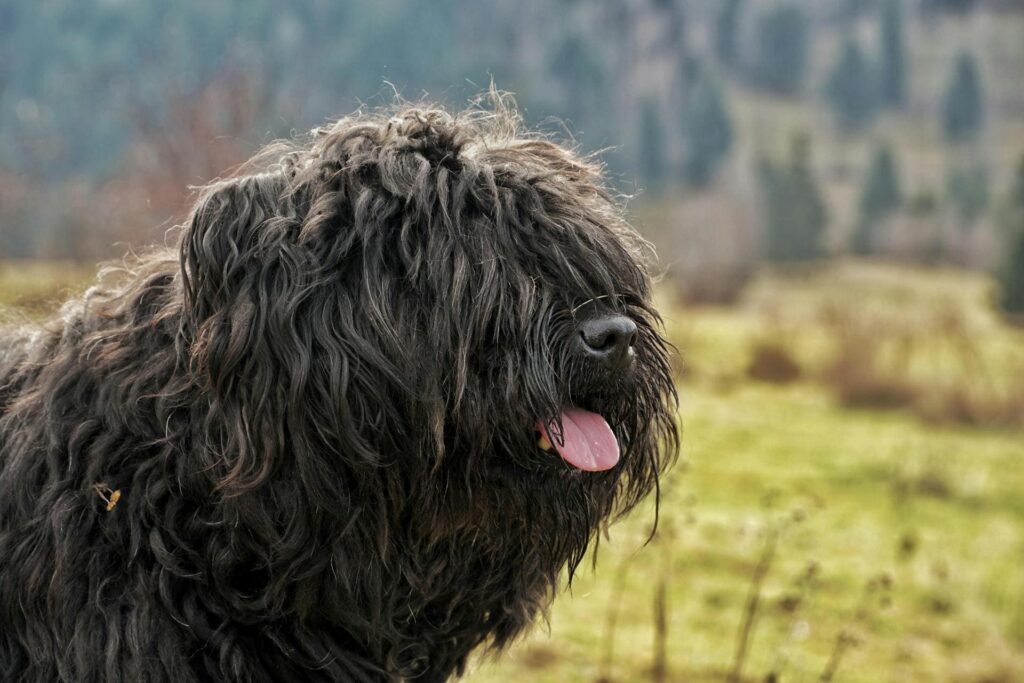
The Bouvier des Flandres may look like a burly barn dog straight out of a medieval tapestry—and that’s not far from the truth. Originally bred in Belgium for cattle herding and farm work, this large, rugged pup combines muscle, brains, and heart in one impressively shaggy package.
Don’t let the rough-and-tumble look fool you: under all that fluff is a loyal, affectionate, and surprisingly calm companion—as long as they’re properly trained and socialized.
Personality Snapshot
Bouviers are:
- Loyal and courageous with strong protective instincts
- Naturally calm and confident
- Smart and steady, though they can be a bit headstrong
- Great with families, especially when raised with children
They do best in homes where leadership is clear, and where their protective nature is guided by consistent socialization.
Grooming Needs
Their dense, tousled double coat is weather-resistant and designed for outdoor life—but it’s no “wash-and-go” situation.
| Grooming Task | Frequency |
| Brushing | 2–3 times per week |
| Tools Needed | Pin brush, wide-tooth comb |
| Professional Grooming | At least once or twice a year |
| Bathing | Every couple of months |
| Shedding | Low to moderate |
This coat is prone to tangles, especially if not brushed to the skin. Some owners opt for regular professional grooming to keep the coat manageable.
Exercise & Training
Bouviers may look like sleepy bears, but they need daily mental and physical activity to stay balanced.
- Long walks, hikes, or off-leash play (in secure areas)
- Advanced obedience, herding, or tracking work
- Consistent training to reinforce boundaries and good behavior
Early socialization is key. Their natural guardian instincts can lead to over-protectiveness if not guided from puppyhood.
Breed Stats
- Size: Large
- Weight: 70–110 pounds
- Height: 23–27.5 inches
- Coat Type: Harsh, tousled outer coat with soft undercoat
- Lifespan: 10–12 years
- Colors: Black, brindle, fawn, gray, salt & pepper
Best For:
| Ideal Home Type | Why They’re a Match |
| Families with older kids | Bouviers bond deeply and are gentle protectors |
| Homes with space | These big dogs need room to roam and stretch |
| Experienced dog owners | Strong-willed pups need confident leadership |
| Active lifestyles | Keeps their body and mind happily engaged |
Final Thoughts
The Bouvier des Flandres is more than just a fluffy face—it’s a working-class hero with a heart as strong as its build. Loyal, protective, and intelligent, this breed shines in homes where training is a priority and affection flows freely.
With that big body and even bigger heart, the Bouvier is ready to be your family’s guardian, snuggler, and forever fluffball—just don’t forget the brush.
What Are Those Big Fluffy Dogs Called?
There’s no single name for them—these cuddly giants come in many breeds, each with their own charm. From the majestic Samoyed to the regal Rough Collie, they all share one thing: a thick, luxurious coat that’s made for snuggling (and needs regular brushing!). They’re often lovingly referred to as:
- Large fluffy dog breeds
- Fluffy giants
- Big fluffballs
Whatever you call them, these dogs are impossible not to adore
What Is the Best Fluffy Dog?
That depends on your lifestyle! Here are a few fluffy favorites matched to different personalities:
- For families with kids: Bernese Mountain Dog or Newfoundland – gentle, patient giants
- For elegant solitude: Chow Chow or Belgian Sheepdog – calm, reserved, and dignified
- For allergy-conscious owners: Standard Poodle – intelligent, hypoallergenic, and glamorous
- For playful personalities: Samoyed or Eurasier – affectionate, smiley, and fun-loving
No matter your choice, there’s a fluffy friend out there for you.
Quick Tips for Big Fluffy Dog Owners
Grooming:
Daily brushing helps reduce shedding and keeps coats mat-free—plus, it’s bonding time!
Exercise:
Big fluffballs need space and movement. Think walks, hikes, yard play, and plenty of stimulation.
Treats Matter:
Big dogs are big chewers. Reward them with healthy, long-lasting treats like our all-natural Yak Cheese Chews 🧡—they’re great for satisfying chewing instincts and supporting dental health.
Space & Patience:
These pups may be gentle, but they take up serious space—make sure your home (and heart) has room
Conclusion
If you’re searching for a big, fluffy dog to add warmth, fun, and extra snuggles to your home, these 15 breeds are full of personality, loyalty, and love. Whether you fall for the playful Samoyed, the gentle Saint Bernard, or the noble Bouvier des Flandres, there’s a fluffy giant just waiting to become your new best friend.
And don’t forget to stock up on Yak Cheese Chews—they’re the perfect post-grooming reward and a boredom buster for your new cuddle buddy.
Which of these fluffy breeds would be your ideal cuddle companion?
👇 Comment below—we’d love to hear which fluffball has your heart!
Find More Dog Breeds.

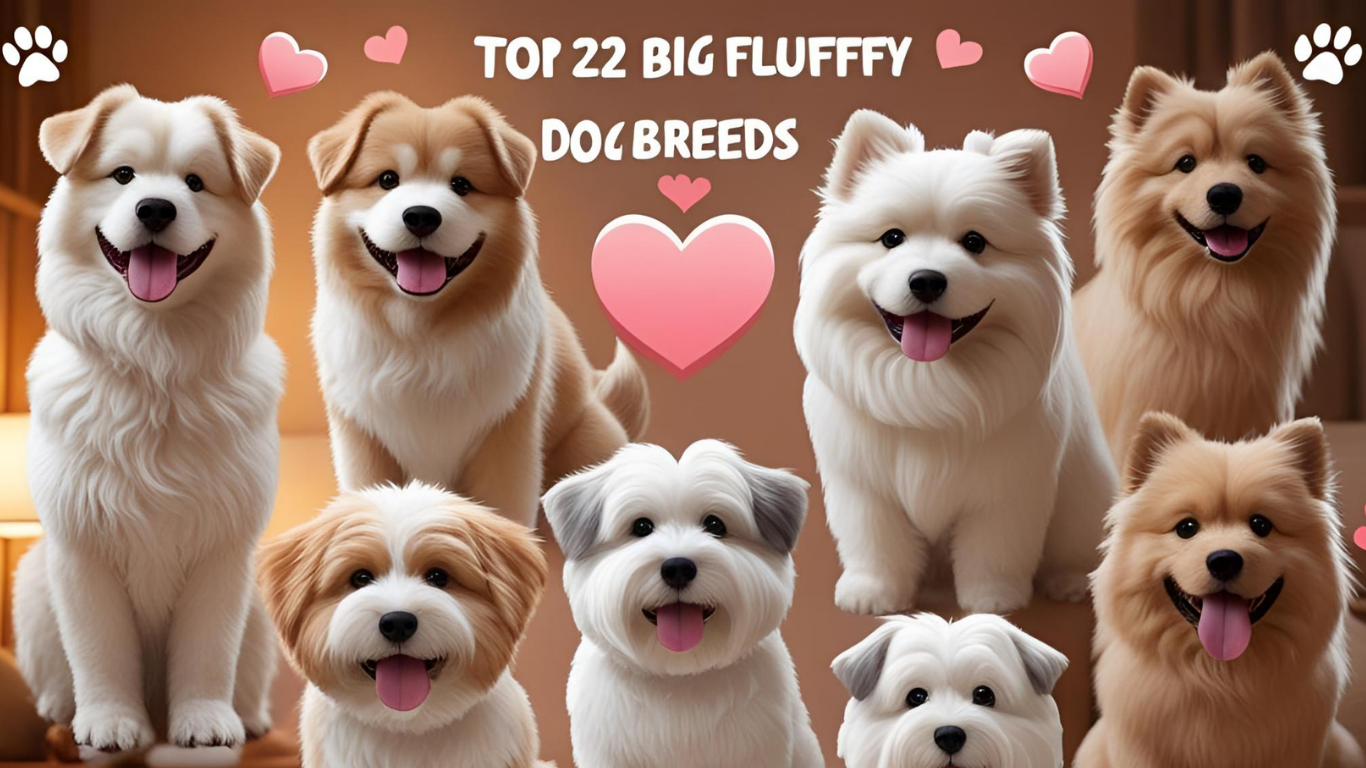



1 thought on “Top 22 Big Fluffy Dog Breeds for Extra Cuddles and Joy”